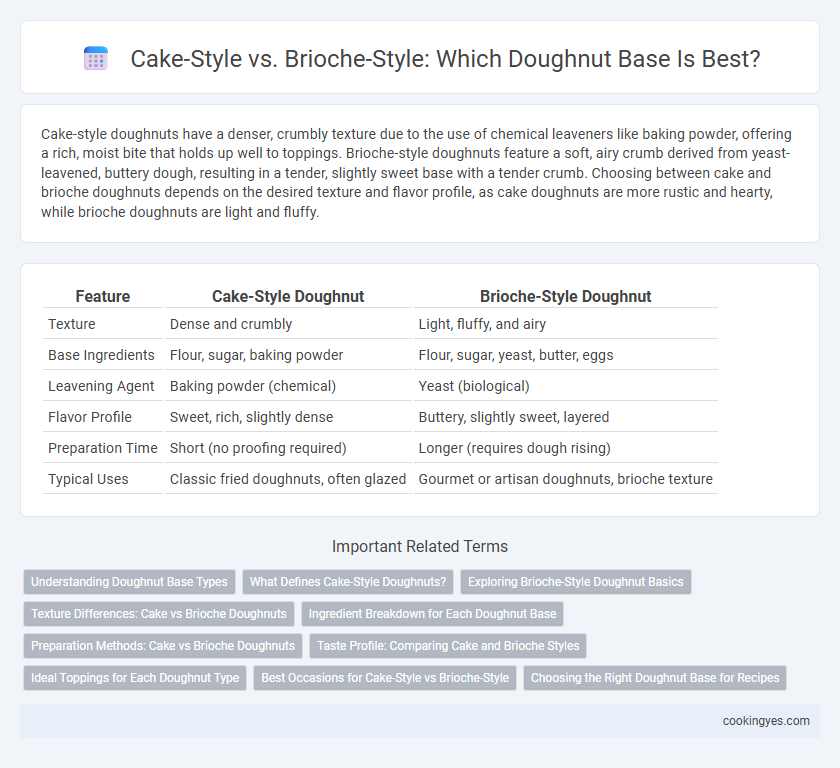Cake-style doughnuts have a denser, crumbly texture due to the use of chemical leaveners like baking powder, offering a rich, moist bite that holds up well to toppings. Brioche-style doughnuts feature a soft, airy crumb derived from yeast-leavened, buttery dough, resulting in a tender, slightly sweet base with a tender crumb. Choosing between cake and brioche doughnuts depends on the desired texture and flavor profile, as cake doughnuts are more rustic and hearty, while brioche doughnuts are light and fluffy.
Table of Comparison
| Feature | Cake-Style Doughnut | Brioche-Style Doughnut |
|---|---|---|
| Texture | Dense and crumbly | Light, fluffy, and airy |
| Base Ingredients | Flour, sugar, baking powder | Flour, sugar, yeast, butter, eggs |
| Leavening Agent | Baking powder (chemical) | Yeast (biological) |
| Flavor Profile | Sweet, rich, slightly dense | Buttery, slightly sweet, layered |
| Preparation Time | Short (no proofing required) | Longer (requires dough rising) |
| Typical Uses | Classic fried doughnuts, often glazed | Gourmet or artisan doughnuts, brioche texture |
Understanding Doughnut Base Types
Cake-style doughnuts are made from a dense, leavened batter often using baking powder or baking soda, resulting in a crumbly texture similar to cake. Brioche-style doughnuts use an enriched yeast dough containing butter, eggs, and milk, producing a light, fluffy, and slightly chewy crumb with a buttery flavor. Recognizing these distinct base types is crucial for selecting the ideal doughnut texture and flavor profile for various recipes or preferences.
What Defines Cake-Style Doughnuts?
Cake-style doughnuts are defined by their dense, crumbly texture achieved through a batter leavened with chemical agents like baking powder or baking soda instead of yeast. This style yields a rich, cake-like consistency that is often moist and tender, contrasting with the airy nature of yeast-based doughnuts. Typically fried at a lower temperature, cake doughnuts have a slightly crisp exterior paired with a soft interior, making them ideal for flavors and glazes that soak into the porous base.
Exploring Brioche-Style Doughnut Basics
Brioche-style doughnuts feature a rich, buttery dough higher in eggs and butter than cake-style counterparts, resulting in a soft, airy texture with a slightly crisp exterior. Unlike the denser, crumbly cake-style doughnut made from chemical leavening agents, brioche dough relies on yeast fermentation, which enhances flavor complexity and chewiness. This yeast-based method requires longer proofing times but yields a more tender, flavorful treat ideal for gourmet doughnut applications.
Texture Differences: Cake vs Brioche Doughnuts
Cake-style doughnuts have a dense, crumbly texture due to a batter made with chemical leaveners like baking powder, creating a tender yet firm bite. Brioche-style doughnuts use enriched yeast dough, resulting in a light, airy, and fluffy texture with a slightly chewy crumb and buttery richness. The texture difference impacts flavor absorption and mouthfeel, with cake doughnuts offering a more crumbly bite and brioche doughnuts delivering a soft, pillowy experience.
Ingredient Breakdown for Each Doughnut Base
Cake-style doughnuts rely on a dense mixture with higher proportions of flour and chemical leaveners like baking powder, resulting in a crumbly texture rich in starches. Brioche-style doughnuts use enriched yeast doughs containing eggs, butter, and milk, creating a soft, airy crumb with a tender, buttery flavor. The ingredient breakdown for cake doughnuts emphasizes dry components and fat, while brioche doughnuts focus on fermentation and moisture from dairy and eggs.
Preparation Methods: Cake vs Brioche Doughnuts
Cake-style doughnuts use a batter similar to cake, consisting of flour, sugar, baking powder, and eggs, resulting in a denser texture with a crumbly bite. Brioche-style doughnuts rely on enriched yeast dough made from high-gluten flour, butter, eggs, and milk, producing a light, airy, and tender crumb with a slightly sweet flavor. The preparation of cake doughnuts involves leavening through chemical agents, while brioche doughnuts undergo fermentation and proofing, contributing to distinct textures and flavor profiles.
Taste Profile: Comparing Cake and Brioche Styles
Cake-style doughnuts offer a denser, crumbly texture with a rich, buttery flavor that often carries subtle vanilla or nutmeg undertones, ideal for absorbing glazes and toppings. Brioche-style doughnuts feature a lighter, fluffier crumb with a slight sweetness and rich eggy notes reminiscent of brioche bread, providing a more airy bite and a delicate balance of buttery richness. Taste preferences usually hinge on whether one favors a hearty, cake-like chew or a soft, bread-like pillow that complements both sweet and savory fillings.
Ideal Toppings for Each Doughnut Type
Cake-style doughnuts, with their dense and crumbly texture, pair perfectly with rich toppings like thick glazes, chocolate ganache, or powdered sugar that complement their hearty base. Brioche-style doughnuts feature a light, airy crumb and buttery flavor, making them ideal for delicate toppings such as fruit preserves, custard fillings, or a simple dusting of cinnamon sugar to enhance their soft texture. Choosing the right topping for each style elevates the doughnut experience by balancing texture and flavor profiles.
Best Occasions for Cake-Style vs Brioche-Style
Cake-style doughnuts, dense and moist with a crumbly texture, excel at casual gatherings like coffee breaks or brunches where their rich flavor pairs well with hot beverages. Brioche-style doughnuts, light and airy with a buttery sweetness, suit special occasions such as brunch parties or holiday celebrations, offering a delicate base for elaborate toppings and fillings. Choosing cake-style favors comfort and heartiness, while brioche-style enhances elegance and indulgence in doughnut experiences.
Choosing the Right Doughnut Base for Recipes
Cake-style doughnuts have a dense, crumbly texture achieved through chemical leaveners like baking powder, making them ideal for recipes needing a sturdier base that holds up well to coatings and fillings. Brioche-style doughnuts are rich and airy with a tender crumb, relying on yeast fermentation and butter for a buttery flavor and soft texture, perfect for recipes emphasizing lightness and a delicate crumb. Selecting between cake-style and brioche-style doughnut bases depends on the desired texture and flavor; cake-style suits robust, flavorful toppings, while brioche-style enhances richness and softness in sweet or savory variants.
Cake-style vs Brioche-style for doughnut base Infographic

 cookingyes.com
cookingyes.com